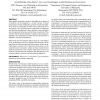Free Online Productivity Tools
i2Speak
i2Symbol
i2OCR
iTex2Img
iWeb2Print
iWeb2Shot
i2Type
iPdf2Split
iPdf2Merge
i2Bopomofo
i2Arabic
i2Style
i2Image
i2PDF
iLatex2Rtf
Sci2ools
HT
2000
ACM
2000
ACM
Generating presentation constraints from rhetorical structure
Hypermedia structured in terms of the higher-level intent of its author can be adapted to a wider variety of final presentations. Many multimedia systems encode such highlevel intent as constraints on either time, spatial layout or navigation. Once specified, these constraints are translated into specific presentations whose timelines, screen displays and navigational structure satisfy these constraints. This ensures that the desired spatial, temporal and navigation properties are maintained no matter how the presentation is adapted to varying circumstances. Rhetorical structure defines author intent at a still higher level. Authoring at this level requires that rhetorics can be translated to final presentations that properly reflect them. This paper explores how rhetorical structure can be translated into constraints, which are then translated into final presentations. This enables authoring in terms of rhetorics and provides the assurance that the rhetorics will remain properly conv...
Final Presentations | HT 2000 | Internet Technology | Rhetorical Structure | Rhetorical Structure Defines |
| Added | 01 Aug 2010 |
| Updated | 01 Aug 2010 |
| Type | Conference |
| Year | 2000 |
| Where | HT |
| Authors | Lloyd Rutledge, Brian Bailey, Jacco van Ossenbruggen, Lynda Hardman, Joost Geurts |
Comments (0)

